



The genus
Recently, the National Fisheries Research and Development Institute (NFRDI) carried out a number of expeditions to in-vestigate fishery resources in the Korean Exclusive Econo-mic Zone (EEZ in 2001-2010). Six species of
The specimens examined in this study were deposited in the NFRDI. The sampling data for the
Carapace length (CL), which measures from the posterior margin of the orbit to the posterior middorsal margin of the carapace, is used to indicate the size of the specimens. The terminology used within descriptions mainly follows that of Chace (1985). Species are arranged in alphabetical order.
[Table 1.] List of sampling data for the Plesionika species addressed

List of sampling data for the Plesionika species addressed
Order Decapoda Latreille, 1802
Infraorder Caridea Dana, 1852
Family Pandalidae Haworth, 1825
Genus Plesionika Bate, 1888
1*Plesionika grandis Doflein, 1902 (Figs. 1, 7A)
Material examined. Korea: Jeju-do: 1♂ (CL 19.8 mm), 1♀ (CL 14.5 mm), 2 ovig. ♀♀ (CL 21.0, 22.0 mm), 2003 I-Tr-13, east of Jeju Island, 5 Apr 2003; 1♂ (CL 19.8 mm), 2004 II #243, south of Jeju Island, 27 Oct 2004; 2 ovig. ♀♀ (CL 19.6, 19.7 mm), 2007 II #221, northwest of Jeju Island, 3 Oct 2007.
Supplemental material. Korea: Busan: 1 ovig. ♀ (CL 20.5 mm), off Dadaepo, shrimp trawl, 11 Mar 2009; 1♂ (CL 16.0 mm), off Dadaepo, shrimp trawl, 3 Aug 2010.
Description. Rostrum (Fig. 1A) moderately curving dorsally, 1.4-1.7 times as long as carapace; dorsal margin with 37-44 teeth, including 6 on carapace, 2 posteriormost teeth with distinct basal sutures; ventral margin with 21-24 teeth. Cara-pace (Fig. 1A) with orbital margin slightly convex in ventral part, regularly concave elsewhere; antennal spine strong, pte-rygostomian spine weak. Abdomen (Fig. 1B) smooth and rounded dorsally; pleura of fourth and fifth somites each with posteroventral tooth; sixth somite 1.7-1.9 times as long as maximum height. Telson (Fig. 1B) usually 1.3-1.4 times as long as sixth abdominal somite, with 3 pairs of small dorso-lateral spines; posterior margin ending in minute median tooth, bearing 3 pairs of marginal spines. Eye (Fig. 7A) sub-pyriform, maximum diameter more or less than 0.2 carapace length; cornea broader than eyestalk. Antennular peduncle (Fig. 1A) with stylocerite acute, barely overreaching distal margin of first antennular segment. Antennal scale (Fig. 1C) 3.9-4.1 times as long as wide; distolateral tooth overreaching rounded blade. Third maxilliped slender, overreaching distal margin of antennal scale by entire ultimate segment and an-terior 0.1 penultimate segment, without epipod; penultimate segment 1.6 times as long as ultimate segment. Pereopods without epipods, not extremely slender or thread-like. Second pereopods (Fig. 1D) subequal; carpi with 22-23 articles. Third pereopod (Fig. 1E) overreaching antennal scale by slightly more than lengths of distal 3 segments; dactylus usually about 0.2-0.3 times as long as propodus; 3 distal segments combin-ed 1.4-1.9 times as long as carapace; merus with 11-13 lateral and 4-5 ventral spines.
Coloration. Body generally pinkish and slightly transparent, with 4 very narrow longitudinal red stripes on abdomen, 3 oblique on carapace, branchial region of carapace deep red; rostrum pinkish with margins red; pereopods with proximal segments somewhat whitish but becoming red distally (Fig. 7A).
Distribution. Indo-West Pacific: Korea, Japan, East and South China seas, Philippines, Indonesia, northwestern Aus-tralia, Zanzibar area of eastern Africa and Madagascar; 92-375 m.
Remarks. This species is a member of the
species-group that was revised by Chan and Crosnier (1991). The species-group is characterized by the rostrum being very long and armed with numerous closely set teeth along almost the entire length of both margins. They also subdivided the species-group into two subgroups (namely the “
1*Plesionika izumiae Omori, 1971 (Figs. 2, 7B)
Material examined. Korea: Jeju-do: 1 ovig. ♀ (CL 12.1 mm), 2002 I-Tr-8, west of Jeju Island, 14 Mar 2002; 2♀♀ (CL 7.2, 7.2 mm), 2003 I-Tr-4, west of Jeju Island, 23 Mar 2003.
Description. Rostrum (Fig. 2A) noticeably curving dorsally, 1.5-1.7 times as long as carapace; dorsal margin with 11-13 teeth, including 4 on carapace, 5-7 posteriormost teeth mo-vable; ventral margin with 13-14 teeth. Carapace (Fig. 2A) with orbital margin convex in ventral part, rather regularly concave in dorsal half; strong antennal and weak pterygos-
tomian spines present. Abdomen (Fig. 2B) rounded dorsally; pleura of fourth and fifth somites with posteroventral tooth; sixth somite 1.7 times as long as maximum height. Telson (Fig. 2B) 1.4 times as long as sixth abdominal somite, with 3 pairs of dorsolateral spinules, posterior margin with 3 pairs of spines. Eye (Fig. 2A) moderately large, maximum diame-ter about 0.2 carapace length. Antennular peduncle (Fig. 2A) with stylocerite sharp, reaching distal margin of first anten-nular segment. Antennal scale (Fig. 2C) 4.2 times as long as wide, distolateral tooth falling distinctly short of distal mar-gin of blade. Third maxilliped overreaching antennal scale by half of ultimate segment, penultimate segment 0.7 as long as ultimate segment, with epipod. Pereopods with prominent epipods on 4 anterior pairs; not extremely slender or thread-like. Second pereopods very unequal; left (Fig. 2D) overre-aching antennal scale by distal 3 segments, with 83-117 carpal articles; right (Fig. 2E) reaching distal margin of antennal scale, with 18-24 carpal articles. Third pereopod (Fig. 2F) overreaching antennal scale by dactylus and half of propo-dus; dacylus about 0.5 times as long as propodus; 3 distal segments combined nearly 1.3 times as long as carapace; merus with 10-12 lateral and 4-8 ventral spines.
Coloration. Body light reddish brown, red bands on bran-chial region of carapace, dorsal part of third abdominal so-mite, margins of first and third abdominal pleura (Fig. 7B).
Distribution. Korea, Japan, South and East China seas, Philippines; 17-300 m.
Remarks. This species is very common in the East China Sea and the northern part of the South China Sea and adjacent waters (Li, 2006b).
1*Plesionika lophotes Chace, 1985 (Figs. 3, 7C)
Material examined. Korea: Jeju-do: 1 ovig. ♀ (CL 16.5 mm), 2004 II #243, south of Jeju Island, 27 Oct 2004; 1 ovig. ♀ (CL 22.8 mm), 2007 II #232, west of Jeju Island, 15 Oct 2007.
Description. Rostrum (Fig. 3A) remarkably curving dorsally,1.5 times as long as carapace; dorsal margin with 14 teeth, including 5-6 on carapace, all teeth on carapace with distinct basal sutures and movable; ventral margin with 13-18 teeth. Carapace (Fig. 3A) with orbital margin convex in ventral part, rather deeply concave posteriorly, become nearly straight dorsally; antennal spine much stronger than pterygostomian spine. Abdomen (Fig. 3B) smooth and rounded dorsally; pleura of fourth and fifth somites with small marginal tooth posteriorly; sixth somite 1.5 times as long as maximum height. Telson (Fig. 3B) 1.6 times as long as sixth abdominal somite; dorsolateral margin with 4 pairs of small spine; posterior mar-gin with 3 pairs of spines. Eye (Fig. 3A) broadly subpyriform, maximum diameter about 0.2 carapace length, Antennular peduncle (Fig. 3A) with stylocerite sharply acute, distinctly overreaching distal margin of first antennular segment. Anten-nal scale about 3.4 times as long as wide, distolateral tooth falling short of distal margin of blade. Third maxilliped over-reaching distal margin of antennal scale by half of ultimate segment, with epipod; penultimate segment about 0.7 as long as ultimate segment. Pereopods with epipods on 4 anterior pairs; not extremely slender or thread-like. Second pereopods unequal, left (Fig. 3C) overreaching antennal scale by distal 3 segment and anterior 0.3 of merus, with 147 carpal articles, right (Fig. 3D) overreaching antennal scale by entire chela and anterior 0.7 of carpus, with 40 carpal articles. Third pere-opod (Fig. 3E) overreaching antennal scale by dactyl and half of propodus; dactylus about 0.3 times as long as propo-dus; 3 distal segment combined about 1.1 times as long as carapace; carpus with 3 lateral spines; merus 12 lateral and 6 ventral spines.
Coloration. Body light reddish orange, with large red circles margined by white on third abdominal somite; carapace and anterior abdomen with scattered white dots; thoracic appen-dages, antennular and antennal flagella with bands of red and white (Fig. 7C).
Distribution. Indo-West Pacific: Korea, Japan, Philippines, Vietnam, Madagascar, southern Arabia, South Africa; 105-329 m.
Remarks. Chan (2004) revised the “
2*Plesionika narval (Fabricius, 1787) (Figs. 4, 7D)
4; Chan and Crosnier, 1991: 443, figs. 12a-c, 13a, 14a-c, 15a-e, 34-36; Miyake, 1998: 61, Pl. 21, fig. 1; Li and Ko-mai, 2003: 265; Li, 2006a: 370; Li and Davie, 2006: 161.
Material examined. Korea: Jeju-do: 1♂ (CL 16.5 mm), 1 ovig. ♀ (CL 15.1 mm), 2004 I #232, south of Jeju Island, 24 Apr 2004; 1♂ (CL 11.3 mm), 2008 I #229, west of Jeju Island, 21 Apr 2008.
Description. Rostrum (Fig. 4A) slightly curving dorsally, elongate, 2.2-2.3 times as long as carapace; dorsal margin with 58-60 serrated teeth, including 5 on carapace, all teeth on carapace with distinct basal sutures and movable; ventral margin with 41-44 serrated teeth. Carapace (Fig. 4A) with orbital margin slightly truncate in dorsal end; strong antennal and weak pterygostomian spines present. Abdomen (Fig. 4B) smooth and rounded dorsally; pleuron of fourth somite round-ed, that of fifth somites with small marginal tooth posteriorly; sixth somite 1.8 times as long as maximum height. Telson (Fig. 4B) about 1.1 times as long as sixth abdominal somite; dorsolateral with 3 pairs of dorsolateral spinules, posterior margin with 3 pairs of spines. Eye (Fig. 4A) broadly subpyri-form, maximum diameter about 0.2 carapace length. Anten-nular peduncle (Fig. 4A) with stylocerite tapered anteriorly, falling short of distal margin of first antennular segment. Antennal scale (Fig. 4C) much slender, about 5.4 times as
long as wide, distolateral tooth reaching beyond distal mar-gin of blade. Third maxilliped (Fig. 4D) slender, overreaching distal margin of antennal scale by ultimate segment and ante-rior 0.2 of penultimate segment, with epipod; penultimate segment about 1.7 as long as ultimate segment. Pereopods without epipod; not extremely slender or thread-like. Second pereopods (Fig. 4E) subequal, overreaching antennal scale by distal 2 segments and half of carpi; carpi with 27-29 articles. Third pereopod overreaching antennal scale by distal 3 seg-ments; merus with 12 lateral and 2-4 ventral spines. Fourth pereopod with merus bearing 13 lateral and 1 ventral teeth. Fifth pereopod with merus bearing 11 lateral and 3 ventral spines.
Coloration. Body transparent whitish or somewhat pink-red, with one subdorsal and one lateral red-margined white stripe; rostrum red with margins somewhat paler in color; pereopods red distally and pink proximally (Fig. 7D).
Distribution. Indo-West Pacific from Madagascar to Poly-nesia, Japan, Korea, and Mediterranean, East Atlantic coast from Gibraltar to Cape Verde Islands, South Atlantic, Red Sea; 35-910 m.
Remarks. The present specimens agree with the diagnosis of Chan and Crosnier (1991). This is the first time that
1*Plesionika orientalis Chace, 1985 (Figs. 5, 7E)
mura and Takeda, 1987: 111, fig. 3a, b; Takeda and Hana-mura,1994: 21, fig. 9; Li, 2006b: 115.
Material examined. Korea: Jeju-do: 1♀ (CL 17.5 mm), 2004 I #239, west of Jeju Island, 18 Apr 2004; 1♂ (CL 12.0 mm), 2010 II #220, northwest of Jeju Island, 13 Nov 2010.
Description. Rostrum (Fig. 5A) moderately curving dorsal-ly, elongate, 2.2 times as long as carapace; dorsal margin, on basal crest only, with 8 teeth, including 3 on carapace, all teeth on partial basal sutures; ventral margin with 42 serrated teeth. Carapace (Fig. 5A) with orbital margin convex in ven-tral part, nearly vertical posteriorly; antennal and pterygosto-mian spines prominent. Abdomen (Fig. 5B) smooth and round-ed dorsally; pleura of first to fifth somites without distinct marginal tooth or denticle; sixth somite about 2.2 times as long as maximum height. Telson (Fig. 5B) subequal to sixth abdominal somite in length; dorsolateral margin with 3 pairs of spinules; posterior margin with minute median tooth, flank-ed by 2 pairs of spines. Eye (Fig. 5A) very broadly subpyri-form, maximum diameter aobut 0.25 carapace length. Anten-nular peduncle (Fig. 5A) with stylocerite bluntly acute, slightly reaching beyond distal margin of first antennular segment. Antennal scale (Fig. 5B) 5.0 times as long as wide; distolate-ral tooth slightly falling short of distal margin of blade. Third maxilliped (Fig. 5D) overreaching distal margin of antennal scale by anterior 0.3 of ultimate segment, with epipod, well developed exopod present; penultimate segment 1.3 times as long as ultimate segment. Pereopods with epipods on 4 anterior pairs, not extremely slender or thread-like. Second pereopods (Fig. 5E) subequal, reaching distal margin of anten-nal scale, carpi with 18-21 articles. Third pereopod over-reaching antennal scale by lengths of dactylus, propodus, and anterior 0.7 of carpus; merus with 11-15 lateral spines. Fourth and fifth pereopods each with merus bearing 8 and 6-7 late-ral spines, respectively.
Coloration. Body transparent whitish or somewhat pinkish tinge, with numerous small spots on carapace and abdominal margins; distal parts of rostrum, antennular flagella and third maxilliped red (Fig. 7E).
Distribution. Korea, Japan, East and South China seas, Phi-lippines, Indonesia; 66-686 m.
Remarks. The specimens agree well with Chace’s (1985) original description and illustrations, and Li’s (2006c) illust-ration from the East China Sea especially in terms of the basicerite of the antenna with the small and short distoventral tooth (Fig. 5A, C).
1*Plesionika ortmanni Doflien, 1902 (Figs. 6, 7F)
Material examined. Korea: Jeju-do: 3♂♂ (CL 13.7-17.2 mm), 1 ovig. ♀ (CL 16.4 mm), 2002 II-Tr-11, north of Jeju Island, 29 Oct 2002; 1♀ (CL 13.8 mm), 2003 I-Tr-12, north of Jeju Island, 3 Apr 2003; 2♂♂ (CL 14.1, 16.5 mm), 2003 II #243, south of Jeju Island, 3 Dec 2003.
Description. Rostrum (Fig. 6A) rather curving dorsally, 1.5-1.6 times as long as carapace; dorsal margin with 17-18 teeth, including 3-4 on carapace, all teeth with partial or complete basal sutures; ventral margin with 6-9 teeth. Carapace (Fig. 6A) with orbital margin slightly convex in ventral part, rather regularly concave elsewhere; antennal spine strong, ptery-gostomian spine rather weak. Abdomen (Fig. 6B) without carina or projection dorsally; pleuron of fifth somite with posteroventral tooth; sixth somite 1.5 times as long as maxi-mum height. Telson (Fig. 6B) 1.5 times as long as sixth abdo-minal somite; dorsolateral margin with 3 pairs of spinules; posterior margin with 3 pairs of spines. Eye (Fig. 6A) sub-pyriform, maximum diameter barely 0.2 carapace length. Antennular peduncle (Fig. 6A) with stylocerite sharply point anteriorly, reaching distal margin of first antennular segment. Antennal scale (Fig. 6C) 4.3-4.4 times as long as wide, disto-lateral tooth reaching narrow distal margin of blade. Third maxilliped overreaching distal margin of antennal scale by entire ultimate segment and anterior 0.2 of penultimate seg-ment, with epipod; penultimate segment 1.4 as long as ulti-mate segment. Pereopods with prominent epipods on 4 ante-rior pairs; not extremely slender or thread-like. Second pere-opods (Fig. 6D) subequal, overreaching entire chelae and half of carpi; carpi with 28-33 articles. Third pereopod
(Fig. 6E) overreaching antennal scale by lengths of distal 3 seg-ments; dacylus about 0.5 times as long as propodus; 3 distal segments combined nearly 2.0 times as long as carapace; merus with 8-12 lateral and 8 ventral spines.
Coloration. Body light reddish brown, 1 prominent white line from branchiostegal region of carapace obliquely back-ward through lateral surface of first to sixth abdominal somites and another white line from lateral surface of posterior half of third abdominal somite to end of telson, with rather broad red line ventrally (Fig. 7F).
Distribution. Korea, Japan, East and South China seas, Philip-pines, Indonesia; 29-400 m.
Remarks. This species is easily distinguished from the Korean congeners due to its diagnostic white line from the branchiostegal region of the carapace to the lateral surface of the sixth abdominal somite.
Key to Korean species of Plesionika
1. Rostrum with dorsal margin armed with closely set teeth, serrate; pereopods without strap-like epipods on coxae ???????????????????????????????????????????????????????????????????????????????????2
- Rostrum with dorsal teeth widely spaced; first to fourth pereopods with strap-like epipods on coxae ????????????????3
2. Fourth abdominal somite with marginal tooth on pleuron; third maxilliped without epipod ??????????????????????????????????????????????????????????????????????????????????
- Fourth abdominal somite without marginal tooth on pleu-ron; third maxilliped with strap-like epipod ??????????????????????????????????????????????????????????????
3. Fourth and fifth abdominal somites each with marginal tooth on pleuron ????????????????????????????????????????????????????????4
- Fourth abdominal somite without marginal tooth on pleu-ron???????????????????????????????????????????????????????????????????????????5
4. Posterior teeth of dorsal rostral series forming distinct crest dorsal and posterior to orbit ?????????????????????????????????????????????????????????????????????????????????
- No prominent crest at base of rostrum ??????????????????????????????????????????????????????????????????????????????
5. Rostrum armed ventrally with fewer than 20 rather widely spaced teeth; fifth abdominal somite with posteroventral denticle on pleuron ???????????????
- Rostrum armed ventrally with more than 20 closely set teeth, serrate; fifth abdominal somite without posteroven-tral denticle on pleuron ??????????
Korean name: 1*줄무늬꼬마도화새우(신칭)
Korean name: 1*점박이꼬마도화새우
Korean name: 1*큰점꼬마도화새우(신칭), 2*흰줄꼬마도화새우(신칭)
Korean name: 1*동방꼬마도화새우(신칭)
Korean name: 1*긴줄꼬마도화새우

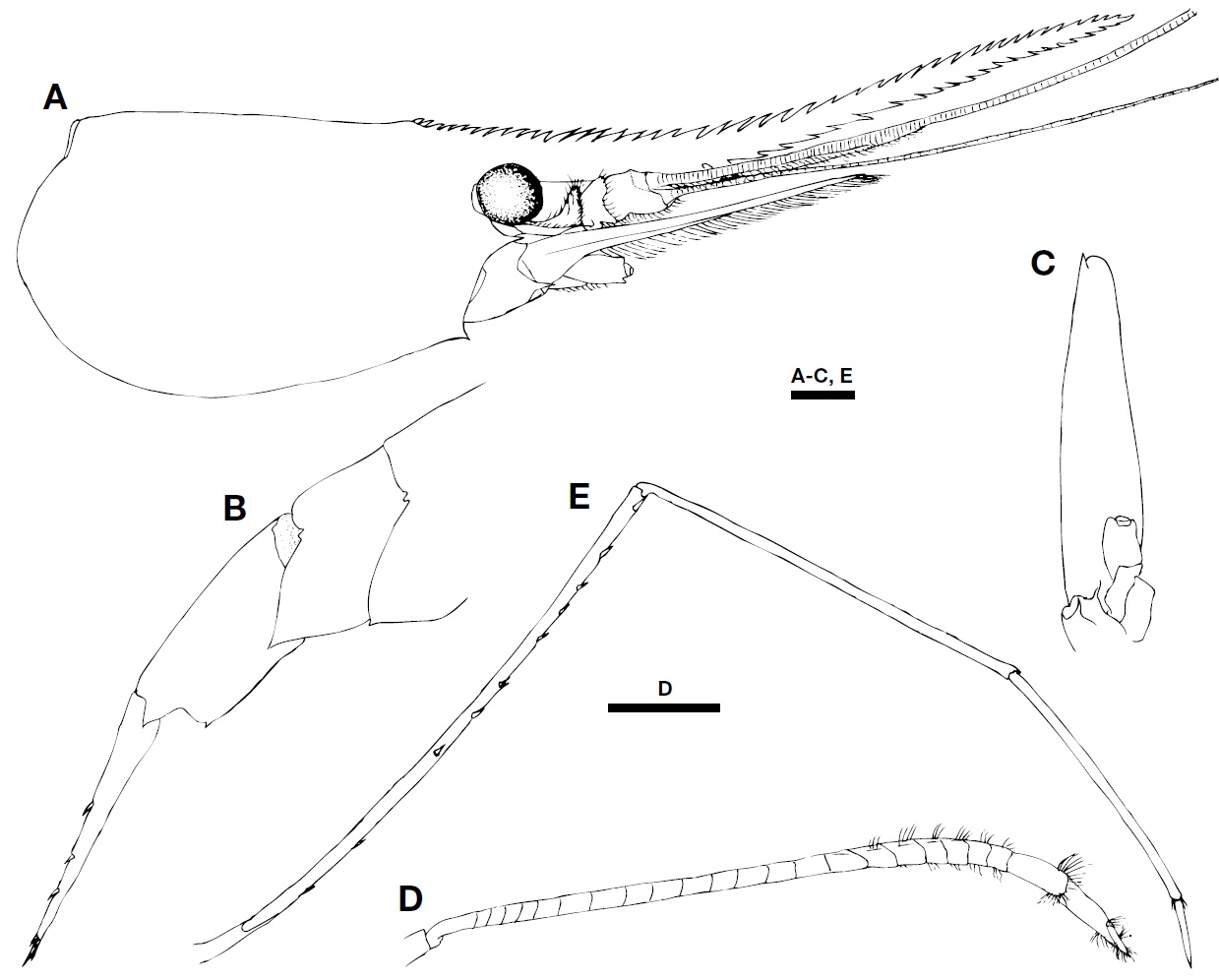
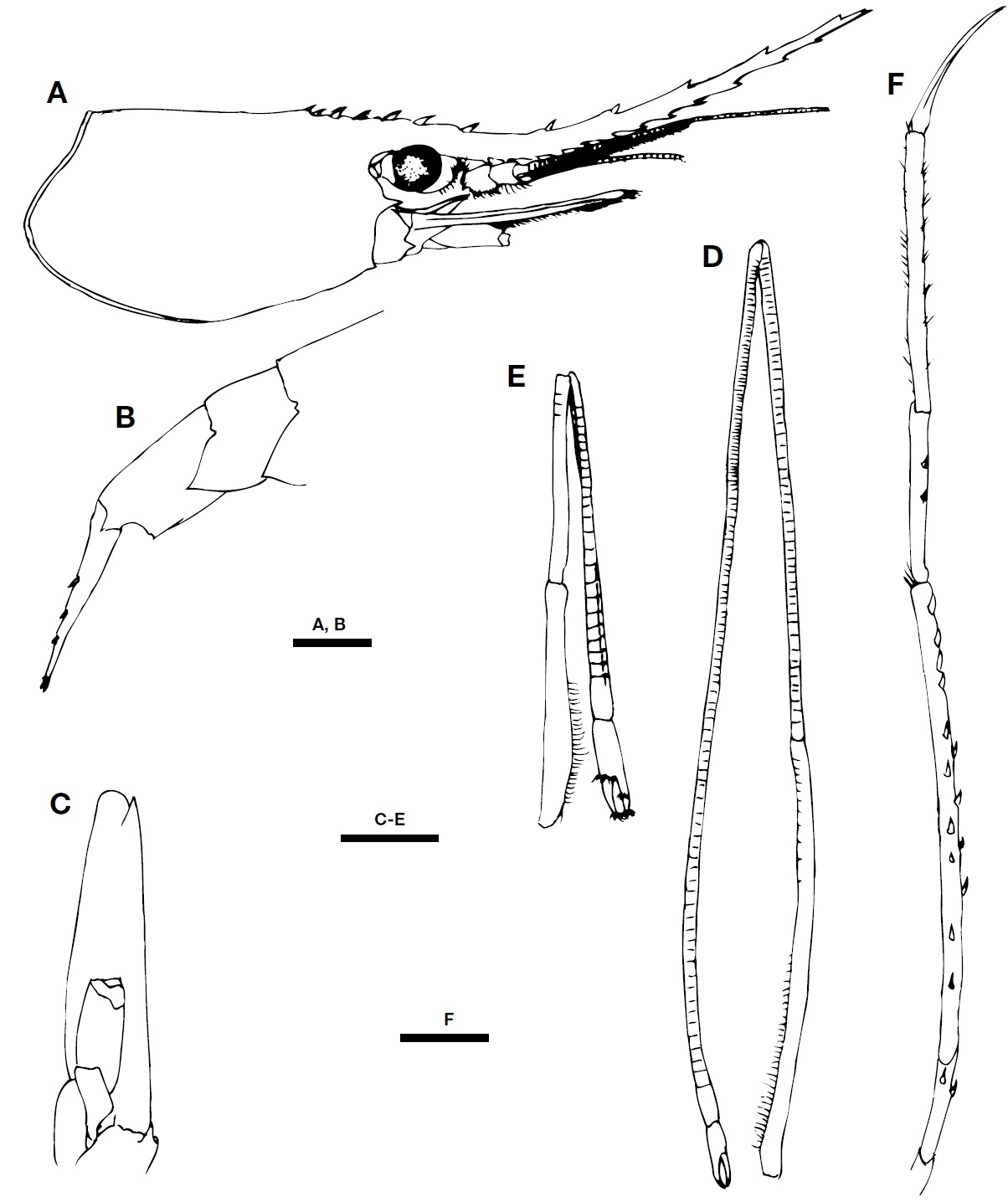
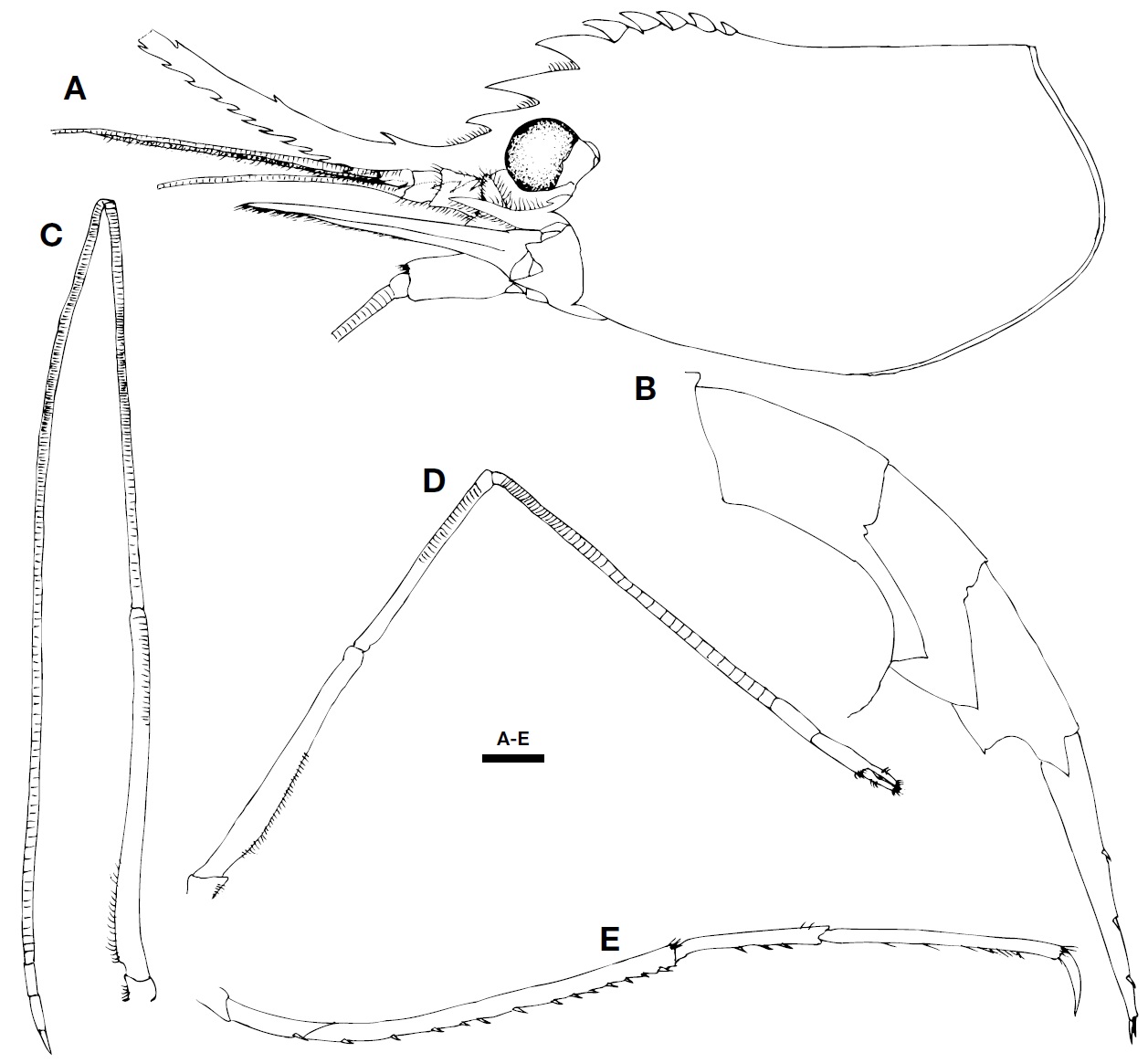
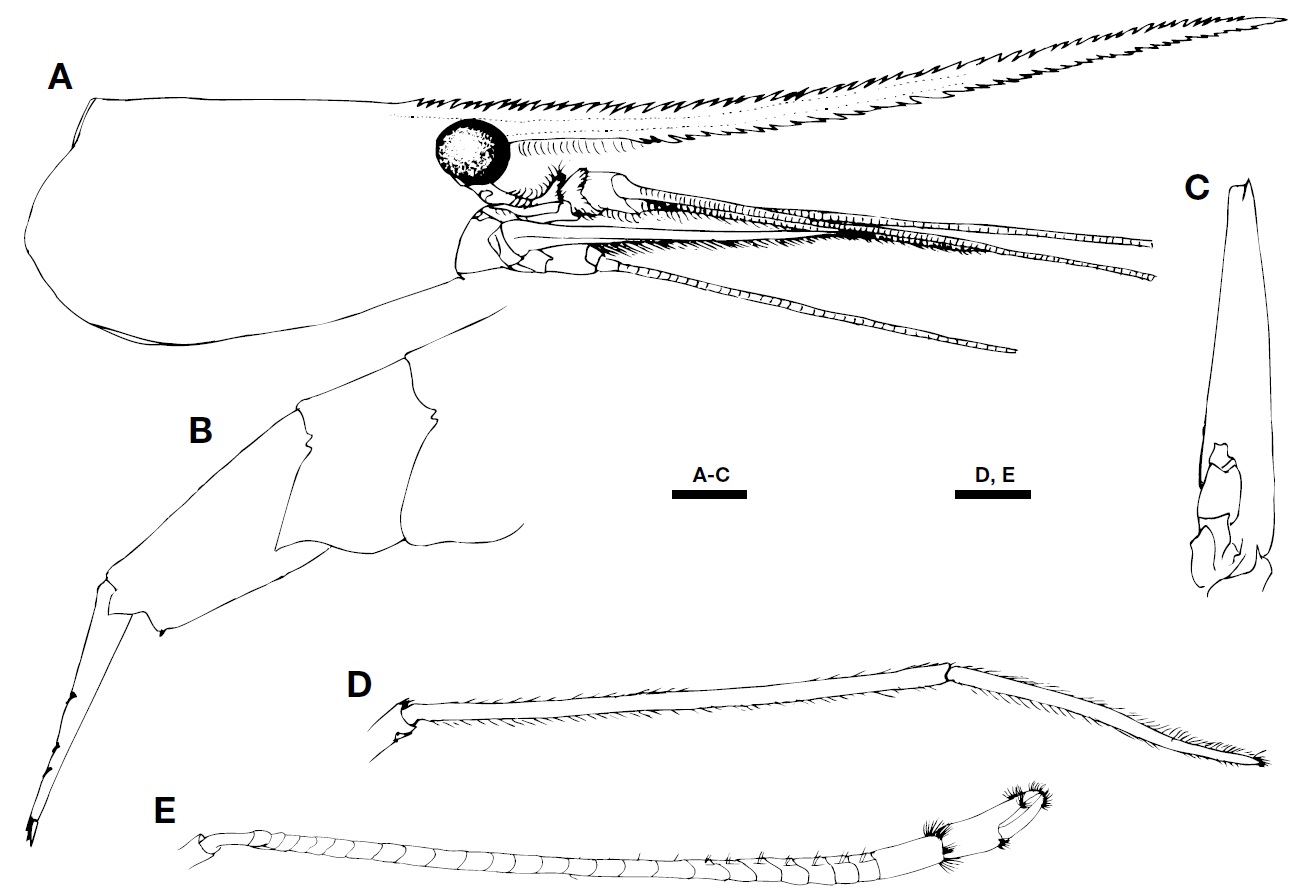
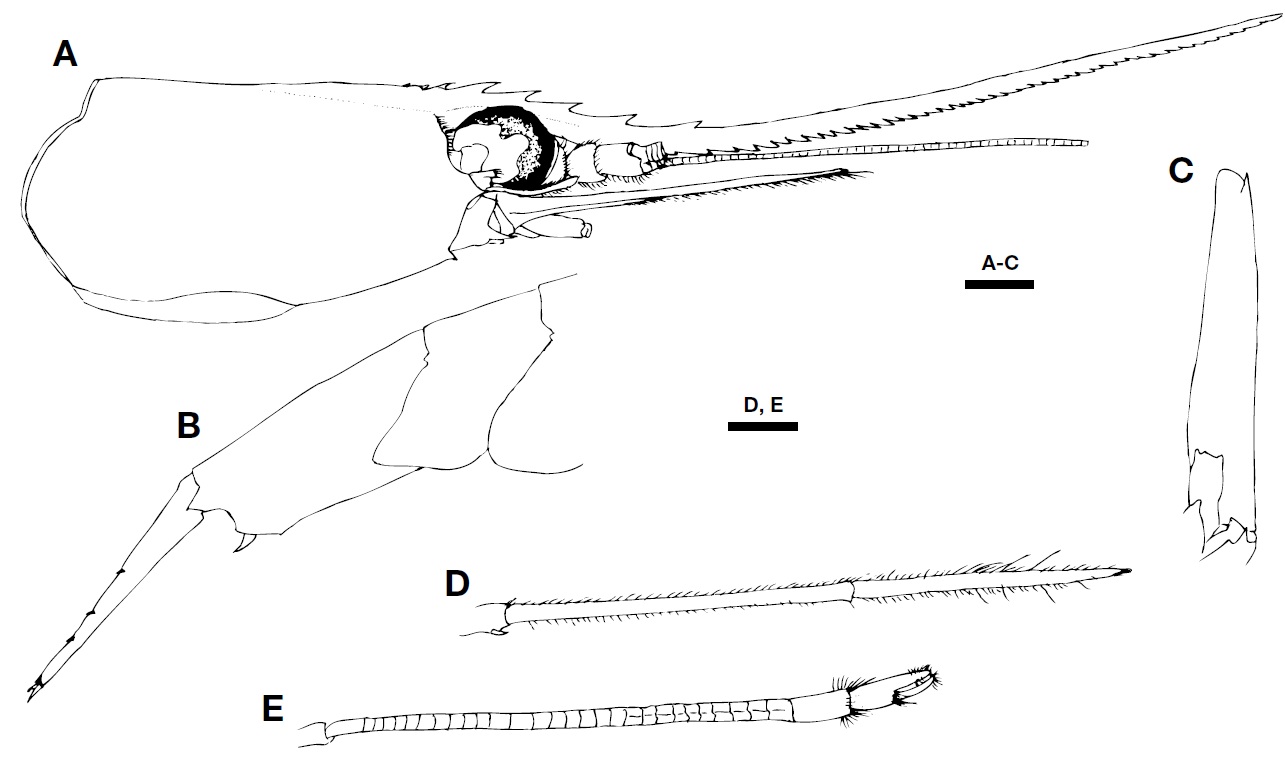
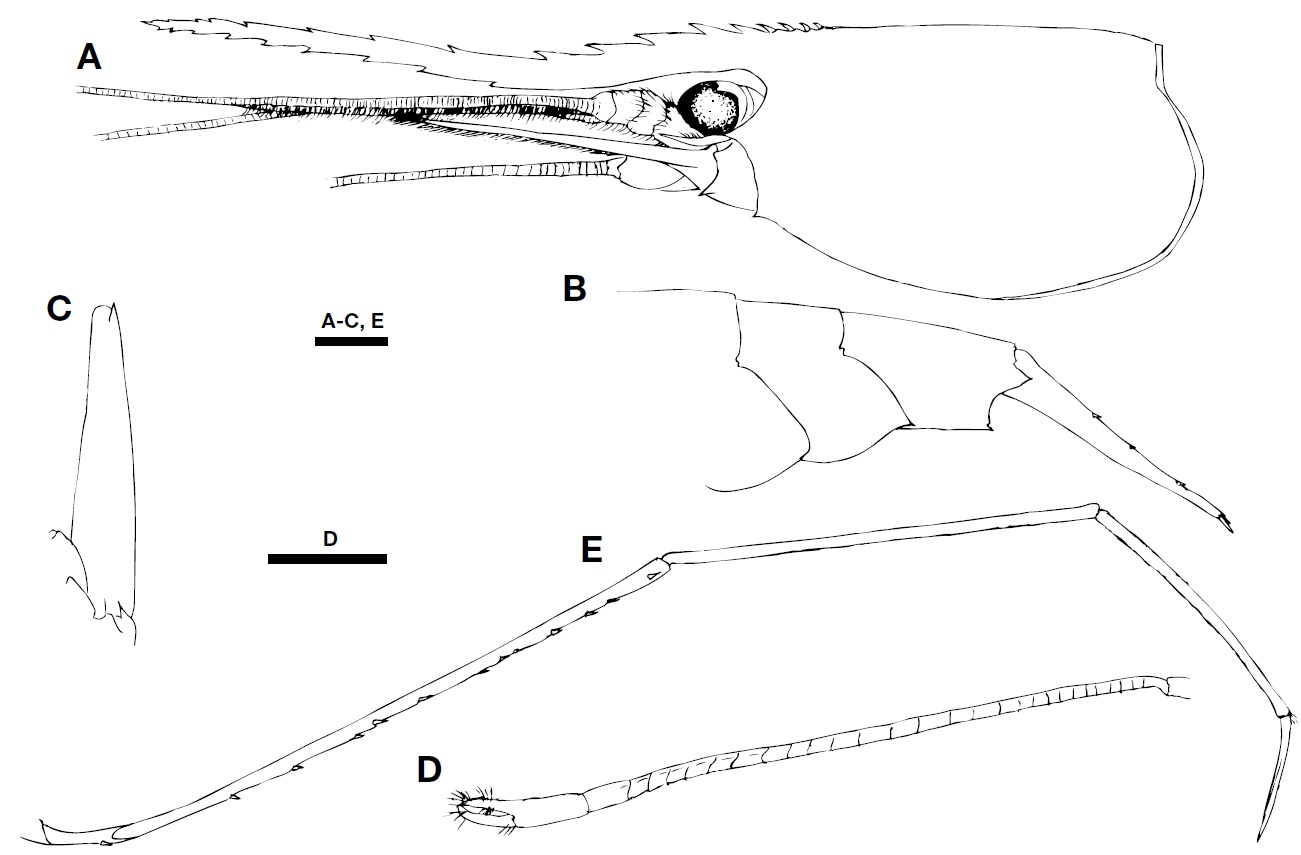
![A Plesionika grandis Doflein 1902: ovigerous female (carapace length [CL] 22.0 mm) from 2003 I-Tr-13; B Plesionika izumiae Omori 1971: ovigerous female (CL 12.1 mm) from 2002 I-Tr-8; C Plesionika lophotes Chace 1985: ovigerous female (CL 16.5 mm) from 2004 II #243; D Plesionika narval (Fabricius 1787): male (CL 16.5 mm) from 2004 I #232; E Plesionika orientalis Chace 1985: male (CL 12.0 mm) from 2010 II #220; F Plesionika ortmanni Doflein 1902: female (CL 13.8 mm) from 2003 I-Tr-12.](http://oak.go.kr/repository/journal/10965/DMBRBT_2012_v28n2_105_f007.jpg)